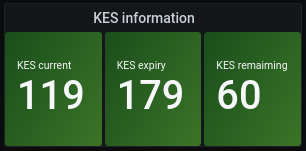Hey people!
Thanks for stopping by, I have some good news for you. But first things first: Lets have a look at the past epoch.
As you can see in the [Pool Update] Epoch 232 we were assigned for one block last epoch and we produced it. This leaves the pool at a performance of 100% considering that we never missed an assigned slot. As all of you may already know (but it can’t be stated often enough) lucky and unlucky epochs level out over time. Some epochs will give us very high rewards while others give us little to no rewards. The fluctuation in the number of blocks is higher for smaller pools but overall this does not mean, that bigger pools will automatically earn you higher rewards. Also keep in mind the long-term development of Cardano, where many unique operators should be favored over multi-pool operators or any kind of stake pool alliances for the stability and security of the network.
Pledge increased, nodes updated & KES renewal
Now I mentioned I have some good news. Many of you may already noticed it: I increased the stake from 25k to 30k last Epoch. As already promised I will keep reinvesting the rewards back into the pool. I started this pool from the beginning with the intention to run it for a long period of time and not to make short-term profits. That’s why I chose the path of open and transparent communication from the very beginning. If everything goes well, you will know it, if something does not go well, you will know it too. I always have an open ear for suggestions, ideas but also criticism. Please feel free to contact me via the possibilities at the bottom of the website.

Since it was time to renew the KES keys and update the cardano-node to the newest version 1.23.0, I took the opportunity and started to move the pool to new servers. I used the Google Cloud Platform before, because there are performant and reliable servers available. However, this platform is also a high cost factor due to its very diverse possibilities and number of innovative products, which are not needed for the operation of a stake pool. Another important reason is that many other pools also use the major cloud services like Google Cloud Platform (GCP), Amazon Web Services (AWS) and Microsoft Azure to operate their pools. In order to follow the idea of decentralization further, I decided to go with a German provider who offers me a much better price-performance ratio while still providing the full range of functions I need. To keep the costs low, I booked the servers for one year in advance. With the new servers we are prepared for much higher loads than currently, but we still have the possibility to increase the capacities even further. And you know what? We are already running on the new infrastructure and have already produced our first blocks. That means the cardano-node update, migration as well as the renewal of the keys went off without any problems 🙂
In the common explorers you will see four running relays at the moment. I will keep the old relays online as long as they are contracted. After that they will be switched off and the pool will only run with the new relays.
Leader Schedule for 233
+----+------------+----------+---------------------+--------------------------+
| # | Status | Block | Slot | SlotInEpoch | Scheduled At |
+----+------------+----------+---------------------+--------------------------+
| 1 | confirmed | 5028643 | 15403790 | 110990 | 2020-12-03 04:34:41 UTC |
| 2 | confirmed | 5029261 | 15416220 | 123420 | 2020-12-03 08:01:51 UTC |
+----+------------+----------+---------------------+--------------------------+Note: The times shown refer to the coordinated universal time (UTC).
As you can see the format of the schedule changed a bit from the format of the last updates and the stolen blocks of the bft nodes are no longer included. I think it is still all well recognizable. As you can see we were assigned two blocks in 233 which we have already produced. This means a performance of about ~108% if we are looking at the ideal (in a statistical sense in relation to our stake) amount of blocks which is 1.86 at this epoch.
Let me know if you like the new leader schedule format or if you want the old one back.
This is it for today. Talk to you soon! 🙂